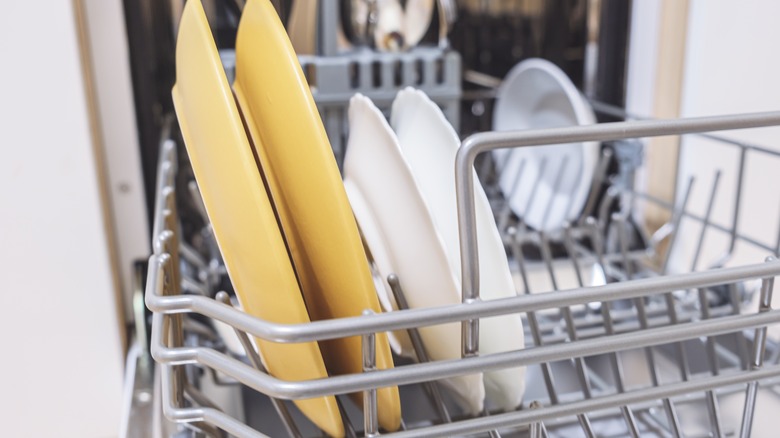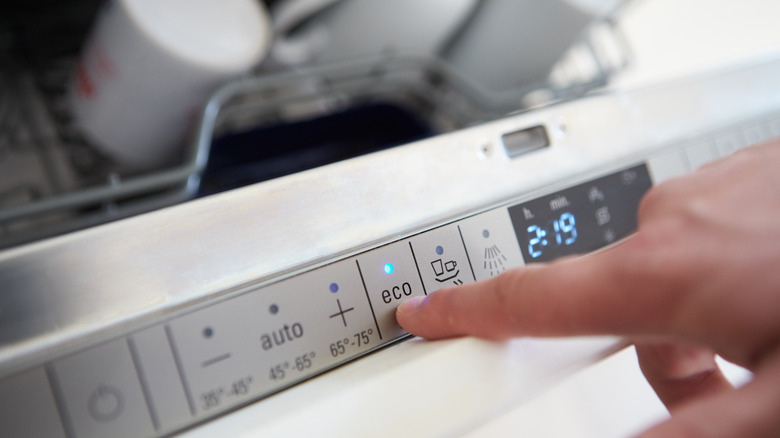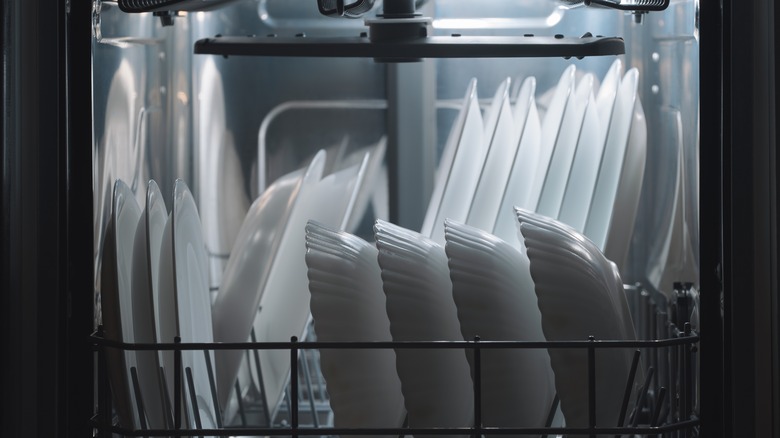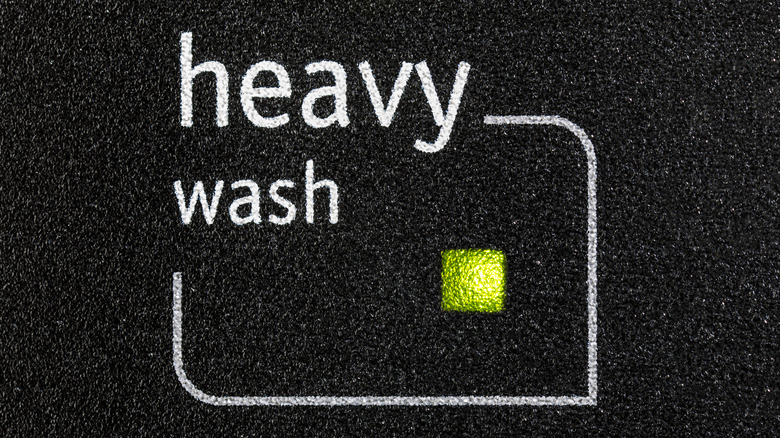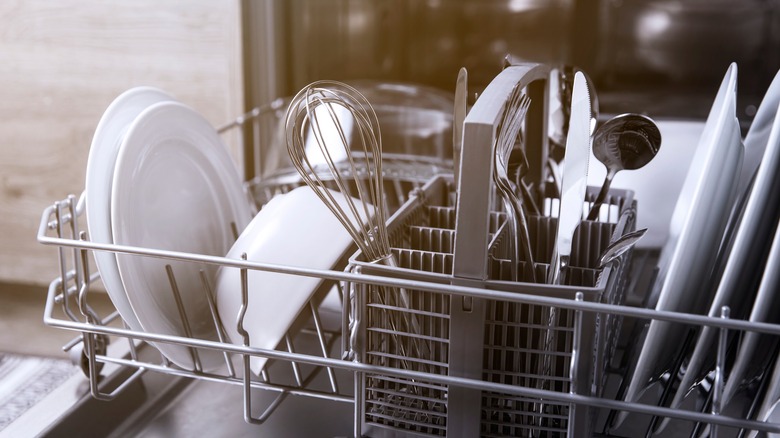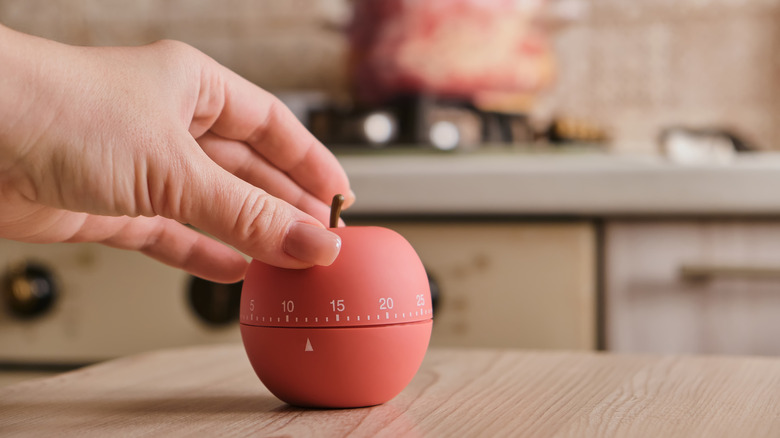All The Dishwasher Settings Explained
Dishwashers might only reduce cleanup time by a few minutes, but these critical seconds can be leveraged for relaxation, time spent with loved ones, or an extra few winks. Gizmodo reports that roughly 75% of American households include a dishwasher today. But, per the U.S. Energy Information Administration, nearly 20% don't use their dishwasher regularly, if at all. This may be a product of ignorance rather than want. After all, owning an appliance such as this signals at least a baseline interest in actually using the function.
A dishwasher full of half-cleaned dishes is one of the most aggravating things you can find in the morning, and this makes for even more work for someone with an early and busy routine. Before heading out to work, there isn't enough time to go over the dishes with a sponge. Add in the fact that you need to occasionally clean the dishwasher, and many give up on the endeavor altogether. But a change in the setting you use to clean cutlery and plates in this appliance might be the only tweak necessary. In truth, there are many settings that a homeowner or a renter should familiarize themselves with. Understanding the nuanced approach that your washer can take to cleaning kitchen utensils can make for a more efficient cleaning routine and a renewed confidence that the appliance will get the job done right.
Quick wash and eco cycles
The quick wash cycle is a great place to start when evaluating the full functionality of your dishwasher. Running a quick wash cycle offers exactly what the name implies. Quick wash cycles typically run from 20 minutes to an hour. This type of washing won't remove heavy staining or caked-on food material. However, it is ideal for lightly used dishes and other kitchen essentials.
The eco setting offers similar low-soil cleaning. Both functions should be used with care because they offer users a tradeoff that only makes sense in certain circumstances. Eco mode saves energy throughout the washing cycle by reducing the volume of water required and the temperature to which the cleaning solution is heated. Unlike a quick wash, which uses full power but at a reduced time, an eco wash will take the same amount of time as a standard cleaning cycle and may even require additional rinsing time. For homeowners who want to start the dishwasher before heading to bed, the amount of time needed is a non-issue, and the energy savings can be impactful.
Delicate wash cycle
The delicate wash cycle provides another crucial function in cleaning dishes. When cleaning glassware, crystal, or fine china, many homeowners opt to hand wash these pieces to prevent breakage in the dishwasher. However, this isn't strictly necessary because your dishwasher includes a delicate setting. The most important cookware in your home, often unveiled at Thanksgiving, Christmas, and other family holidays likely should be washed by hand every time you use them. But this setting can be implemented to save a significant amount of time.
Cleaning up after a dinner for 12 adds another daunting task to a host's plate. Instead, this setting uses lower temperatures and a light spray to produce a gentler approach to scrubbing, per GE Appliance. This ensures that items set on for a wash won't move around during the cycle and potentially break and maintain their color vibrancy. China pieces may be trimmed or sport hand painting to increase their beauty — a delicate wash will protect these finishing touches and ensure both cleanliness and longevity.
Prewash, high temperature, and heavy wash cycles
The heavy cycle and other intensive cleaning settings provide the opposite effect. Instead of creating a delicate rinsing sensation that protects fragile items, this approach hogs the pieces inside. Prewash settings add heavy rinsing action that mitigates the need to soak soiled dishes before placing them in the dishwasher. This is great for pots and pans that you routinely cook with and wash with the help of your appliance.
High-temperature settings and the heavy wash cycle require additional water and naturally bring higher temperatures to the equation. The heavy wash requires extra cleaning time, sometimes as much as four hours. As a result, they can produce cleaner dishes, even when the items in question have caked-on food particles and dried and sticky residue that aren't easy to lift without intense scrubbing. These cycle settings make the hardest parts of cleaning up after dinner easier and can drastically improve your workflow in the evening. It's important to plan out your use of a more intensive wash. These settings may not be suitable for more delicate glassware that you use regularly.
Heat dry, heated rinse, and extended dry
Heating additions provide increased washing and drying power. The hotter the water, the more potent its ability to strip away grime will become. The same can be said for drying. Heated dry settings eliminate the manual drying you'll have to do with a towel after your dishes are finished and ready to be put back in the cupboards.
The heated rinse function adds hot water to the final rinse, increasing the ambient temperature inside the unit –- and that of the items themselves –- as the washer prepares to remove moisture from the environment. This allows for more effective evaporation as fresh air is pushed into the space to start drying.
An extended dry combines the heated rinse function with a heated dry cycle. The two in tandem can drastically improve the speed at which your dishwasher finishes the last phase of its duties. This feature also helps prevent the formation of water spots on glasses. Although, it should be noted that hot air may degrade the functionality of your items faster than standard air drying.
Sanitizing settings
The last cycle settings you might need from time to time are the sanitize option and the timer. The timer allows you to set the dishwasher to start later: It's pretty straightforward but beneficial. Setting your timer can effectively give you control over when the appliance will run, pushing its use into a nighttime pattern of activity that takes advantage of lower electricity costs, for instance. You might also be a bit forgetful and opt to set the dishwasher directly after dinner. However, the cycle can be noisy, interrupting your precious downtime.
Sanitize settings are not often deployed, but adding this additional function to your heavy wash cycle from time to time will ensure that bacteria won't remain on your cookware. The National Sanitation Foundation reports a standard final rinse temperature of 150 degrees Fahrenheit to sanitize the items being washed. This setting can add more than an hour to the total wash time and drastically increase the electricity and water required to complete the cleaning. Therefore, it should be used sparingly.
